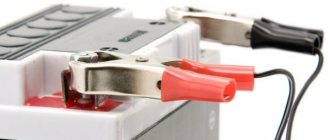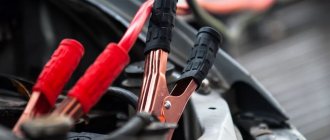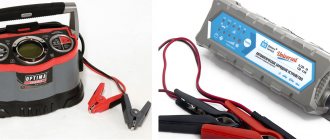When operating a car, there is always a need to maintain and recharge the battery, which will allow you to operate the car without problems in the winter season. We will tell you in more detail how to properly charge the battery, which can easily be done at home.
Most often, problems with batteries occur in the cold season, when the battery is subject to increased load, and due to the physical and chemical properties of the electrolyte and lead plates, they hold a charge less well, which leads to a rapid breakdown of the battery. We can recommend that, for preventive purposes, you recharge the battery in the fall before the onset of cold weather, and in winter, if your battery is dead, you need to remove it from the car as soon as possible and perform the appropriate recharging at home.
To charge a car battery, you can use both purchased DC rectifiers and those you make yourself. Such equipment is not complicated, so it is quite possible to make it yourself even with minimal knowledge in the field of electrical engineering.
Purchased devices for recharging the battery have an appropriate voltmeter, which greatly simplifies the use of such equipment. The car owner can visually monitor the battery charge level, and when the required electric current levels are reached, the battery stops charging. Remember that it is not recommended to recharge the battery for more than 25 hours, since the electrolyte may boil from such overheating and the plates will short-circuit with each other.
The charging devices used must have the ability to smoothly manually or automatically adjust the current, which will ensure the highest quality charging of the battery. Experts recommend performing most of this charging at a current of 6 Amps, and only at 90% of the battery charge the current power decreases first to 3 Amps, and then to 1.5 Amps. This reduction in current will ensure the battery is fully charged.
Why is it worth unscrewing the plugs when charging?
The plugs should be unscrewed, primarily due to the formation of increased pressure inside the battery housing. When electric current is applied to the terminals for a long time, the electrolyte begins to “boil”, and the formation of a large amount of gas can cause deformation of the housing.
Increased pressure can also negatively affect the integrity of the lead plates, especially if an old battery is being charged. A new car battery can also be damaged, because explosive gases are formed inside the case, which are easily ignited by a spark.
If a battery explodes, the electrolyte will fly in different directions, which can lead to chemical burns to the skin, eyes or fire. A caustic substance can also damage almost any item not made of plastic, rubber or glass.
Note! To avoid an explosion, it is better to always unscrew the plugs; the battery should be in a well-ventilated area so that gases do not collect. In addition to being highly flammable, they are also poisonous.
When should you unscrew and when not?
Sometimes it’s better to unscrew the “caps”, sometimes you can leave them, there are several options for the development of events, so in order:
- The battery is new, it is below full charge, say 12.4V (should be 12.7V), you just want to recharge at a low current, say a couple of hours - in this case you don’t need to unscrew the plugs, I would even say - it’s right that you don’t unscrew it. After all, there is electrolyte vapor inside, which can simply escape into the environment, causing an explosion (if there are sparks or fire nearby), and recharging for a couple of hours will not do anything bad if you carry it out correctly (current and voltage).
- The battery is fresh, but completely discharged. Then it’s better to unscrew it, because you want to check the density of the electrolyte. Afterwards you need to charge for a long time at a low current, again it is advisable to observe the appearance of bubbles.
- The battery is old and boils quickly. Be sure to unscrew the plugs! It is important! Old batteries boil quite quickly; this inability to hold a charge indicates that the battery is already “almost dead.” If you do not unscrew the plugs and charge the battery for a long time, it can really burst.
Novice motorists always have many questions, many of them due to existing gaps in knowledge and at the same time the fear of damaging the car (part). Over time, knowledge related to auto topics increases, experience grows, self-confidence grows - some of the questions disappear by themselves. But there are also some among them that can cause controversy even among experienced car owners, for example, whether it is necessary to unscrew the plugs when charging the battery. But really, is it necessary? Let's figure it out.
Do you always need to unscrew the plugs?
If there is a possibility of dust, water, engine oil or fuel getting inside the cans, it is better not to remove the caps. If you need to charge the battery in a room where electrical wires may spark or work with open flames is planned, then it is also better to leave the battery case sealed.
If the battery needs to be recharged within 20 - 30 minutes with a standard current, then in this case you don’t have to unscrew the plugs, because dangerous pressure simply will not have time to form inside the case.
If a maintenance-free battery was independently converted into a serviceable one, then in many cases you can leave the plugs in the battery case. Such batteries are made using calcium technology and in order to achieve strong gas formation, it will be necessary to supply electric current to the battery terminals for too long a time.
Important! All batteries are equipped with special gas outlets through which gas must be discharged at increased pressure in the housing, so if the valves are cleaned of dirt, then the caps do not need to be unscrewed.
Precautionary measures
You only need to unscrew the plugs when the charger is disconnected. If this is done while charging, too much hot gas may escape through the holes, which can be ignited by the slightest spark.
For the same reason, smoking is prohibited during this operation. Before opening the battery case, you should also make sure that there are no open flames, spiral heaters or incandescent lamps near the battery.
Work on unscrewing plugs should be carried out with gloves and safety glasses. It is almost impossible to determine in advance the gas pressure inside the housing, so after removing these elements, gas can escape outside, carrying with it the smallest drops of a caustic substance.
It is important to carry out this operation in a well-ventilated area. A sufficiently large amount of poisonous gas accumulates inside the battery, which can lead to serious poisoning.
As you know, inside any car battery there is a special liquid called electrolyte . It contributes to the accumulation of charge, and without it, the battery principle would not have manifested itself. However, the electrolyte has quite a lot of properties, for example, when discharged, it can simply freeze , and when charging, it begins to boil. And if it boils, does that mean pressure is being created? Therefore, it seems like it’s logical to unscrew the plugs when charging or not? Let's think...
THE CONTENT OF THE ARTICLE
The question is not straightforward, and of course it is asked only by people with so-called serviceable batteries, which have these plugs on top of the batteries. After all, there are also unserviced options where there may not be such traffic jams - that is, a kind of closed, hermetically sealed space.
Again, there are different types of traffic jams:
- Those that protrude are easy to “pick up” with your hand and unscrew, because they rise above the surface.
- Which are made on the same plane with the surface, they are no longer so easy to turn out, although everything is relative.
How to unscrew plugs correctly
If the plugs rise above the surface of the battery cover and have a tetrahedral surface, then they can be easily removed using a suitable wrench.
It is much more difficult to deal with those that are recessed into the body. As a rule, they have a cross-shaped depression on the surface. Using a wide slotted screwdriver you can easily unscrew them. You can use a chisel or knife, but be careful not to cut your hands or drop debris into the jar.
It is not recommended to use chisels and a hammer to remove tightly twisted plugs. Of course, with the help of these tools it is possible to remove the plugs, but they will be severely damaged. Their further use after this method of dismantling remains a big question.
Conclusion! Relatively speaking, if the plugs are unscrewed, then it is better to unscrew them, and if not, then it is necessary to clean the gas outlet channels.
Several opinions.
Paul:
“I definitely take it off, because this is how hydrogen is released. And if the contact between the banks is bad, it can jerk so much that it doesn’t seem too small. I prefer to play it safe. And the electrolyte expands, the battery can simply “suffocate.”
Zhenya:
“It all depends on the charger, if you have it not “antediluvian”, but modern, then the device itself will not allow the acid to boil, limiting the current at the end, so you don’t have to play “games” with twisting/twisting.”
Sergey:
“In order to know whether it is necessary to unscrew the plugs when charging the battery, you only need to inspect the latter. If there is a “hole” in the side of the lid, you don’t have to open it, if not, be sure to unscrew it!
It often happens that in order to service or diagnose a battery, access to the electrolyte is necessary, which means removing the cover.
Batteries are divided into batteries with access to electrolyte and without access to electrolyte. On batteries with access to the electrolyte, either plugs are installed (unscrewed with a ruble coin or a screwdriver), or a single cap-bar, which can be removed with a screwdriver. Before removing, make sure your battery is not listed in the list of batteries below.
Charging the battery
But if the battery still fails you, then the first thing you need to do is charge it before running to the store for a new one. Usually, even a completely tired battery after charging can go for another week or two without problems and turn your starter several dozen times.
The main mistakes car owners make when charging the battery Very often, even experienced drivers forget about some important points when charging, although hundreds of articles have already been written and said about this and even everything is reflected in detail in the battery operating instructions.
Carrying out this procedure in a house or apartment.
It is prohibited to charge the battery in a room that is not ventilated, and a living room is not the best place for this. Firstly, it is not so easy to create drafts here, and secondly, cases of battery explosion cannot be ruled out, although this does not happen so often.
2. Smoking or using open fire near the battery.
If, when electrolyte vapors are released, there is an open fire or even a spark from a cigarette near the battery, you risk exploding the battery. Remember this important point and never smoke or use fire nearby.
Connecting the battery to the device is live.
Very often, beginners make similar mistakes and can pay with their health. Remember: connect the charger to the terminals only when the device is disconnected from the network. Why? This may cause arcing when connecting to the terminals. And about the consequences of sparks, read the previous paragraph and everything will become clear.
Leave the caps in the jars closed.
If you have a serviceable battery, then each bank has its own plug, or they are all covered with one common one. They must be opened, and if this is not done, then at a sufficiently high charging current, the battery case may be damaged as a result of an explosion of electrolyte vapors. If the battery is maintenance-free, then it has one plug in the ventilation channel; we also remove it while charging.
Set the charging current too high.
You should not do this, because in such modes the battery will exhaust its life much faster and you will have to buy a new battery much more often if you neglect this rule - set the charge current equal to 10% of its capacity. That is, if you have a battery with a capacity of 60 Ampere-hour, then you need to charge it with a maximum current of 6 Amperes.
How to remove the battery cover Varta, Bosch, Atlas, Delkor, Bost, Banner
If you want to remove the cover from a Varta, Bosch, Atlas, Delkor, Bost, Banner car battery, calm down, you won’t be able to do this. If you want to remove the battery cover itself, on which the pole terminals are located, then know that it is hermetically sealed at the factory and does not imply removal - the battery can be thrown away.
If you want to remove the single cover-bar, then it covers the labyrinth system for condensation of vapors, which you will also not be able to dismantle. But it all depends on why you need to remove the cover from the battery. If you need to measure the electrolyte level, you can get by by weighing the battery on a scale and comparing the indicators with a new battery. If you need to measure density, it will be easier to measure the voltage and calm down. If you need to add distilled water, then you can be smart and make thin holes without damaging the labyrinth system, and pour water into it using a medical syringe. After pouring, the holes must be soldered.
A battery is a chemical source of current, for which certain chemical processes must occur to function properly. As the battery discharges, sulfuric acid “sticks” to the negative electrode, forming insoluble lead sulfate, leaving
Very often you can hear recommendations about hybrid batteries from salespeople in car dealerships. So what is a hybrid battery? A hybrid battery for a car is externally indistinguishable from other acid batteries, except for the ethical designation
Author Andryushka
I asked a question in
the Service, Maintenance, Tuning
: Do I need to unscrew the plugs when charging the battery? and got the best answer
Answer from Yorgey Dmitrochenkov[newbie] If the battery is new, holds well, and you simply recharge it in cold weather (1 hour, 30+30 minutes...) - not necessary. If the battery is old, in any case, unscrew the plugs and check the density and level of the electrolyte.
Reply from StranniK
[guru] Yopt
Reply from Micah
[guru] yes it is necessary if you don’t unscrew the plugs it can explode
Answer from Vage Pogosyan
[newbie] yes, I’m stabbing myself now
Reply from the Ministry of Internal Affairs
[guru] Be sure not to explode
Reply from Kostya
[newbie] of course... and remove the marks))
Answer from Pavel z.
[guru] definitely, hydrogen is released when there is poor contact between the banks and it tears so much that it doesn’t seem like enough. and the electrolyte expands and the battery can simply suffocate.
Reply from Alexander
[guru] Where did you find a battery with screw caps in these days))
Answer from Igor Veselov
[expert] don’t lie, comrades. In my production, with our winters, diesel generators and trucks and cars are charged from the starter! You just need to set the voltage correctly!
Reply from Andrey Andrey
[guru] When charging, hydrogen is released, so you need to unscrew the caps and you can only smoke at a respectful distance,
Reply from Zh
[guru] If you have a modern charger, you don’t need it - modern chargers limit the current at the end of charging (when hydrogen is mainly released)
Reply from Sergej Piter
[newbie] Of course we should. But it depends on Akum. If there are holes in the lid, there is only one on one side, then you don’t have to open it. And this is definitely necessary.
Reply from Ikla
[guru] if it’s not possible to do this, then set the amps lower when charging and nothing bad will happen, the only thing is that the charging time will increase, otherwise I see they scared you with an explosion, on old batteries there are holes in the plugs and the battery breathes through them, but on new ones too There is where the electrolyte will come out when boiling.
Answer from Oriy Ivanov
[expert] and the plugs on my battery are sealed. Only on the side there is a flap that I remove when charging
Modern power supplies for cars require less and less human participation during operation. Maintenance-free batteries do not need to be topped up with water or electrolyte throughout their entire operating life. If the owner likes the battery, but the indicator indicates that the resource is exhausted, is it possible to restore the battery? How to open the battery and get the lead plates for fishing?
The maintenance-free nature of the power supply is attractive for those who do not want to worry about the condition of the power source once again. At the same time, many are accustomed to monitoring all elements of the automotive system. It is traditionally believed that a closed battery cannot be opened. Indeed, there are no technical holes on the body of such batteries. However, if you want to make a car battery serviceable or remove lead from it, then you can disassemble a maintenance-free power supply. To do this, you will need some tools and knowledge of safety rules.
What are the differences between maintenance-free batteries?
To answer this question, you need to understand in general terms the principle of operation of lead-acid batteries. They work in two modes:
- Discharge. When current is applied, the lead that makes up the negative electrode reacts with the electrolyte and turns into a sulfuric acid salt (lead sulfate). As a result, the density of the acid solution decreases.
- Charging is a recovery process. When voltage is applied to the terminals, the lead sulfate contained in the electrolyte is reduced to metal on the negative electrode, and the density of the acid increases.
When, when charging from an increased voltage (more than 15.6 V), the electrolyte becomes low in lead sulfate, electrolysis of the water contained in the solution begins . It breaks down into gases - oxygen and hydrogen, which is visually accompanied by bubbles - the battery “boils”. In old-style power supplies, this was considered a normal process, because the density of the solution was constantly controlled through holes with plugs made in each jar.
New batteries, called maintenance-free, are manufactured in a sealed case - this is their main difference. To increase the reliability of elements placed in a closed space, the following changes were made to the design:
- to extend the service life of products, they began to add calcium and silver to lead;
- to remove gases, a special valve is provided in the housing that does not allow water vapor to pass through, which helps maintain water in the solution;
- To control the electrolyte level, windows are installed or part of the body is made of translucent plastic.
Due to the tightness of the case, there is no excess evaporation, but it is also impossible to add electrolyte or water to the battery. This means that it needs to be charged in compliance with the optimal voltage and current values in order to avoid a decrease in the acid level due to boiling.
Safety precautions
Attention! A sealed battery contains an acid solution. Contact with unprotected skin may cause burns.
- We strongly recommend using protective equipment when disassembling the power supply. It is strictly forbidden to turn over or shake the jars. This may cause a short circuit.
- If the battery cover is secured with fasteners, be careful not to break them. In the event of a breakdown, the part will have to be glued, and this does not guarantee safe operation of the power source.
- If you want to split the battery using a tool, choose special products that will help protect your eyes from splinters.
Can we safely say that a maintenance-free battery can be made into a serviceable one? Of course, a closed battery can be remade! If the purpose of opening the battery is to extract lead for fishing or hunting, then by observing a number of precautions, you can easily do it with just a hammer.
Charging procedure
To successfully charge a maintenance-free battery, primitive chargers made in the Middle Kingdom or in a garage with your own hands from an old transformer are not suitable. Ideally, you need a device that supports the following functions:
- automatic maintenance of charging voltage at the level set by the user;
- data on the current voltage and current should be shown by devices or on a digital display;
- operation in a cyclic charge/hold/discharge mode, which promotes desulfation of lead plates.
If you plan to work with the battery in the garage, then it is not necessary to remove it from the car . Before charging a maintenance-free car battery with a charger, you will have to disconnect the on-board power supply terminals. This will clear controller errors and user settings. There is no big problem here, just some inconvenience. Then proceed according to the recommendations:
- Connect the wires from the charger to the power source, observing the polarity. Usually on serial devices the “+” and “-” icons are stamped directly on the “crocodiles”.
- Assess the voltage supplied by the battery. If it turns out to be below 11 V, then you are dealing with an unusable and completely discharged battery; it is almost impossible to restore it.
- To begin, set the voltage to 12.6 V, turn on the device to charge and observe the process for 30-60 minutes. Abrupt changes in the ammeter readings, as well as rapid boiling of the electrolyte, indicate a high probability of an internal short circuit in the battery. You will have to stop charging and think about buying a new source.
- If the listed negative signs are not observed, then increase the voltage to 14.4 V. During the charging process, the current will gradually decrease. Focus on the lower limit of the ammeter reading of 0.5-1 A, upon reaching which the charge must be stopped, otherwise the electrolyte will boil. This completes the recovery procedure.
How many kilometers can an electric scooter travel on 1 charge?
Fans of compact vehicles are often interested in how many hours it takes to charge an electric scooter. In this case, it all depends on the specific model. The device can travel from 20 to 60 km on a single charge . But the range indicated in the characteristics of the scooter may be reduced for certain reasons:
- moving over uneven surfaces;
- synchronization with mobile application;
- large body weight of the user;
- high speed of movement;
- cold weather.
Speaking about how long an electric scooter lasts to charge, it is worth noting that the minimum duration of its operation with all functions turned on is 1.5-2 hours . The maximum depends on the presence or absence of the above factors.
Do I need to charge a maintenance-free battery?
Manufacturers and sellers of this type of product claim that the motorist has no need to worry about the condition of the closed battery. With a normally functioning generator and electronic voltage regulator, the power source will receive the necessary amount of energy for a full charge, which will last a long time.
Practice shows negative statistics: on intensively used vehicles, the average service life of a lead-acid battery is 2 years, maximum 3 years. The reasons are as follows:
- When driving in urban conditions, the amount of mileage required to restore the charge does not correspond to the number of engine starts. That is, to fully charge, you need to drive at least 100 km, and the engine stops and starts in the city every 35 km (on average). This means that the battery is barely half charged.
- The supply of stable voltage from the automobile alternator is ensured by a special regulator and relay. When one of these elements does not function correctly or fails, the battery is constantly running low and is not restored.
- In winter, the capacity of the power supply spontaneously decreases due to low temperatures. Combined with the above factors, this results in a charge drop of up to 20%.
Operating a maintenance-free battery in this mode will significantly shorten its lifespan. This benefits manufacturers and sellers of automobile parts, but not car owners. If some old products with opening cans could be restored by adding acid and running a charging current of 10 A, then sealed closed-type batteries can only be thrown away after complete discharge. After all, with a high current, the electrolyte will boil away, and it is impossible to replenish its supply .
Hence the conclusion: despite the assurances of manufacturers, the battery must be periodically charged at home. It is advisable to perform the procedure at a positive temperature, then the service life of the product will increase.











